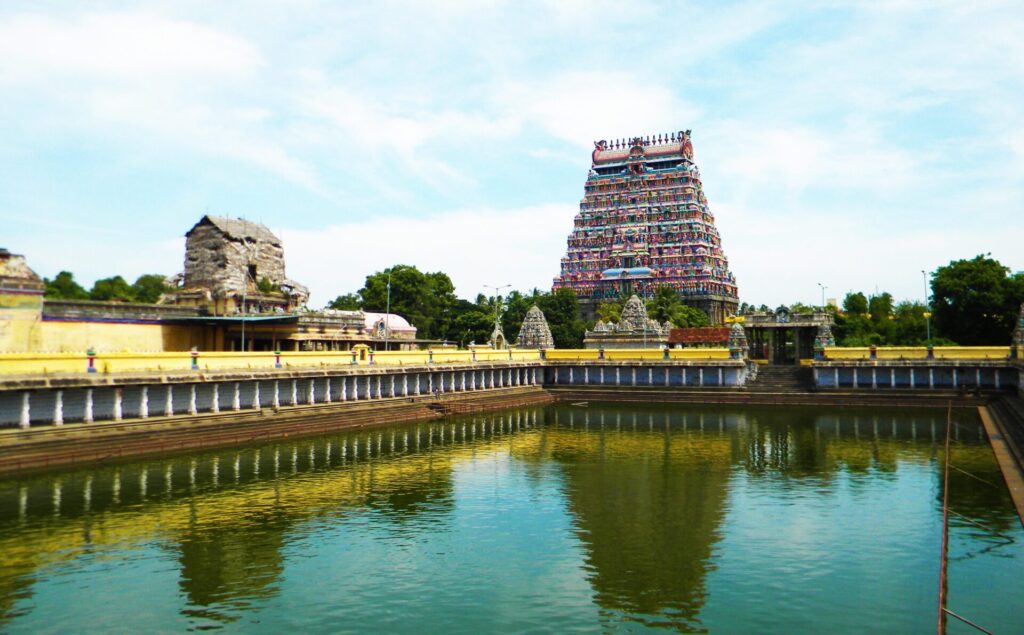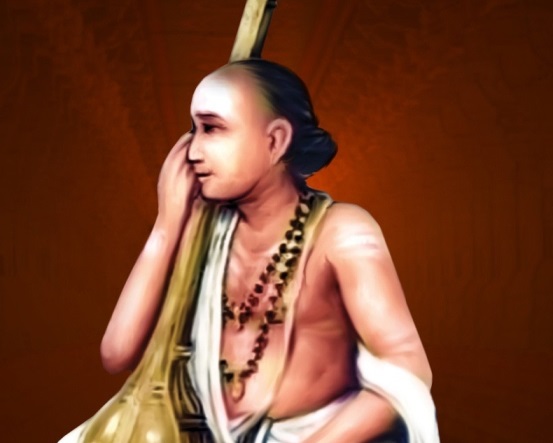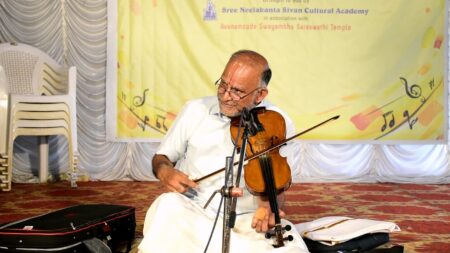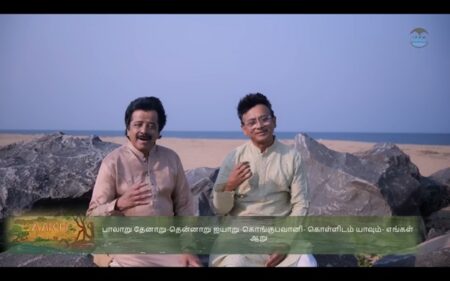Unlike his compositions praising Krishna, Oothukkadu Venkata Kavi’s kritis on Shiva are not popular. But they are unique in many ways.
Carnatic composer Oothukkadu Venkata Subbaiyer’s ( also known as Oothukkadu Venkata Kavi(1700-1765)) compositions praising lord Krishna are very popular. The story goes like this. Devoted to Krishna even from a young age, he desired to learn music the proper way. Having been refused by several gurus, Venkata Subramanian was advised by his mother to pray at the Krishna temple and seek guidance from the Lord himself. He was blessed as the Lord himself averred that he will be the guru. It is not surprising that his favorite God is Krishna and he painted intricate details of Krishna’s life into a canvas.
However, Oothukkadu Venkata Kavi did not restrict himself to composing on Krishna. It is just that the songs on Krishna were the ones that were made available and hence became popular. Lord Shiva appears to have been one of his favourite gods as well. He has composed several songs based on Periya Puranam written by Sekkizhar which describes the life of the nayanmars.
Chidambaram is one of the most famous of the shiva kshetrams, if not the most important. Many consider Chidambaram as the center of this universe. Lord Shiva was supposed to have danced here to fulfil the desire of two devotees, Patanjali and Vyagrapadar. Actually, Patanjali was none other than Adisesha who wanted to witness Shiva’s dance, on hearing Vishnu’s description of the cosmic dance. Vyagrapadar prayed to obtain the tiger’s claws so that he could find the sacred Vilva leaves without difficulty to worship Shiva. Chidambaram is also unique in the sense that Shiva is worshipped here as Nataraja whereas in other places he is worshipped in the form of a lingam.
The Nataraja idol itself has inspired many a poet and sculptors. Appar’s description is very famous:
Venkata Kavi is the only composer who named all the 63 nayanmars in a song – Alavadhennalo – one of the Saptaratna kritis. He cries out in all humility –
Alavadhennalo shivame adiyark adiyark adiyanai meelatha
(When do I become one of a slave of a slave of a bhakta?)
He then voices his true wish.
punmai piravigal poga vendum
eduththal punniya piravigal aga vendun
innavaril oruvarai poie
Enough of these bad incarnations (births). One should be born as one of those blessed incarnations – like one of these….)
And then the poet lists out the names of the nAyanmArs. He ends the song with an emphatic “nan inai onrum illa padhaththinaiyaga vendum”.(I should become equal to an unequalled quality) The word “padham” has several meanings- a state of future bliss, brightness, type of musical composition, line of a stanza etc. All of them can fit in this context!
Worshipping Shiva
Oothukkadu Venkata Kavi must have been influenced by the Shiva temple in his native village of Oothukadu but he has also travelled to several Shiva temples such as Chidambaram, Madurai, Thiruvarur and Thiruvanaikkaval. Of the four songs he had composed on Chidambara kshetram, three are in Sanskrit and one is in Tamil.

Chidambaram is one of the most famous of the shiva kshetrams, if not the most important. Many consider Chidambaram as the center of this universe. Lord Shiva was supposed to have danced here to fulfil the desire of two devotees, Patanjali and Vyagrapadar. Actually, Patanjali was none other than Adisesha who wanted to witness Shiva’s dance, on hearing Vishnu’s description of the cosmic dance. Vyagrapadar prayed to obtain the tiger’s claws so that he could find the sacred Vilva leaves without difficulty to worship Shiva. Chidambaram is also unique in the sense that Shiva is worshipped here as Nataraja whereas in other places he is worshipped in the form of a lingam.
The Nataraja idol itself has inspired many a poet and sculptors. Appar’s description is very famous:
kuniththa puruvamum kovvai sevvayil
kumizh sirippum paniththa sadaiyum
pavalam pol meniyil pal venneerum
iniththamudaiya eduththa porpathamum kanappetrai
manitha piraviyum venduvathe immanilaththe
(Arched eyebrows, smile on the red lips, matted hair, white stripes of sacred ash on body akin to coral, and the raised golden feet – if I get to see all this your birth as a human on this Universe is a blessed one indeed)
The cosmic dance performed at Chidambaram represents five attributes. Shrishti or creation symbolized by the drum in the hand of Shiva, sthiti or preservation symbolized by the abhaya (fear not) gesture, samhara or destruction symbolized by the fire, tirobhava or illusion symbolized by the foot planted on the ground, anugraha or emancipation symbolized by the foot held aloft.
Shiva is also worshipped in the “formless form” of the Chidambara Rahasyam. The temple is known for its AkAsa Lingam, an embodiment of Shiva as the formless Space or ether.
Oothukkadu Venkata Kavi’s song in Tamil, ‘Kanaka sabha nayaka’ is tuned in the raga Nattai and includes an exquisite madhyamakalam bit at the end, ideal for a dance finale, considering that a thread of dance terms run through the song. After all, the song is on the Lord of the dance!
The composer begins by addressing Shiva as ‘Kanaka sabha nayaka’ (the Lord of Golden Arena) and then further as “gathi tharum thillai chidambaresa”. The double reference to the place ‘thillai’ and also ‘chidambaram’ is interesting. The word ‘thillai’ actually denotes a tree by that name, indicating that the place derived its name from the forest of thillai trees. Chidambaram is thought to be a corruption of the word ‘chitrambalam’ – meaning the ‘little open arena’.
Five Shiva temples, among many, are referred to as the five sabhas where Shiva is said to have danced to please various devotees. Chidambaram is known as the kanaka (golden) sabha, Thiruvilankadu as the ratna (diamond) sabha, Tirunelveli as the tamira (copper) sabha, Kutralam as the chithira (murals) sabha and Madurai as the rajatha (silver) sabha.
“mathimugavalli kuvintha nesa” – another reference to Shiva as the consort of Parvati who is described as one with a face like a moon. ‘kuvin’ is archaic usage meaning ‘worship with hands folded’. “mangalanga natana raja siva mahesa” – more addresses to Shiva and finally hailed as the king of dances.
Then in the anupallavi, the composer slips into his usual “musical” mode. Narada and three thousand Brahmins singing the praise of Shiva even as Chandeesan and Nandi keep beat to the cries of sankara sambO. The cosmic dance of bliss was performed to the accompaniments of music played by several divine personalities in the Hindu pantheon. This dance is said to have been witnessed by Vishnu, and there is a Govindaraja shrine in the temple commemorating this.
In the charanam, Oothukkadu Venkata Kavi addresses Shiva as “vedakkattile vilaintha meignana” which endows Shiva as the embodiment of knowledge. He also places Shiva at the center of the web of music “nAdhamennum mooladharak koottile naduvirukkum vilivande” and then emphatically states that the five syllables (om namachivaya) are sweet on the tongue – “naviloorum amudhagiya panchakshara”
Significance of ‘Five’
Everything about Shiva is five. He has five faces. His name consists of five syllables; He danced at five places (sabhas) representing the five elements. The cosmic dance represents five attributes in the circle of life. In Chidambaram, five silver-plated steps lead to the shrine (and they represent the five letters of Namasivaya). The temple has all five Sabhas of Shiva – Chit Sabha, Kanaka Sabha, Nritya Sabha, Deva Sabha and Raja Sabha.
The composer’s choice of words in the last stanza is fascinating. First, he places Shiva as a bee (viLivandu) at the center of a web (koodu as in silanthi koodu – a spider’s web). Then he concludes the stanza with a comparison to a beautiful flower which yields good honey – naRunthEnai* aLiththa* nanmalarE*). The poet perhaps is implying that the Lord is both the honey as well as the bee which feeds on it!
The honey bee and the flower have been extensively used as metaphors in Indian literature, not just to depict Sringara rasa but in other areas as well. Various poets and composers have used them in myriad ways to convey different thoughts and philosophies. Some of them very unusual indeed.
Allama Prabhu, a 10th Century Shivaite saint had a very novel idea. He sees the bee as knowledge. In a poem (translation by A.K.Ramanujam given below), the philosopher states, cryptically:
When the honey-bee came
I saw the smell of flower run
Oh! What miracle!
Where the heart went
I saw the brain run
When the god came
I saw the temple run.
(The smell referred to here is the smell of past lives and the bee is the perfect knowledge of god; the “temple” is the body)
And finally, Venkata Kavi launches into a madhyamakala jathi – his own prompt for a bout of ananda tandava perhaps. The temple, the legend, the beautiful idol of Nataraja- all have served as inspiration to so many composers. No wonder Gopalakrishna Bharathi who had composed so many songs on Chidambaram and Nataraja said:
Sabhapathikku veru dheivam samanamaguma
(Can any God be equal to Sabhapathi?)




